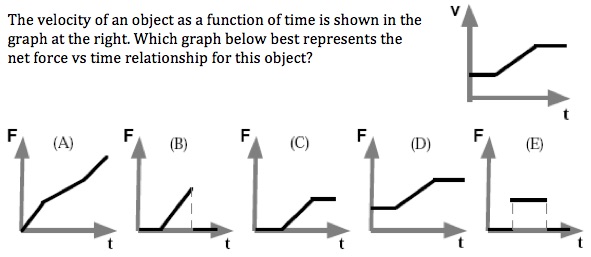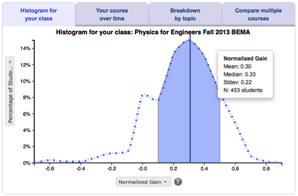Developed by David Hestenes and Malcom Wells
| Purpose | To assess more formal dimensions of basic Newtonian physics and to be used alongside the FCI to get a well-rounded picture of students’ understanding. |
|---|---|
| Format | Multiple-choice |
| Duration | 45 min |
| Focus | Mechanics Content knowledge (kinematics, forces, momentum, energy) |
| Level | Intro college, High school |
Sample question from the MBT:
MBT Implementation and Troubleshooting Guide
Everything you need to know about implementing the MBT in your class.
Login or register to download the implementation guide.
more details
This is the third highest level of research validation, corresponding to at least 3 of the validation categories below.
Research Validation Summary
Based on Research Into:
- Student thinking
Studied Using:
- Student interviews
- Expert review
- Appropriate statistical analysis
Research Conducted:
- At multiple institutions
- By multiple research groups
- Peer-reviewed publication
The multiple-choice answers to the MBT questions are based on research into student thinking. Some of the questions come from Advanced Placement (AP) exams. There is a strong correlation (0.68) between the FCI and the MBT for a group of university students. Item response theory was used to look at the difficulty of the questions and their ability to discriminate between students of different levels. There were five questions that were found not to be effective at discriminating between students of different abilities. The MBT has been administered to over 5000 students at the university and high school level and used to compare teaching methods. Results are published in three peer-reviewed articles.
References
- C. Cardamone, J. Abbott, S. Rayyan, D. Seaton, A. Pawl, and D. Pritchard, Item response theory analysis of the mechanics baseline test, presented at the Physics Education Research Conference 2011, Omaha, Nebraska, 2011.
- D. Desbien, Modeling Discourse Management Compared to Other Classroom Management Styles in University Physics, Arizona State University, 2002.
- D. Hestenes and M. Wells, A mechanics baseline test, Phys. Teach. 30 (3), 159 (1992).
- A. Pawl, A. Barrantes, D. Pritchard, and R. Mitchell, What do Seniors Remember from Freshman Physics?, Phys. Rev. ST Phys. Educ. Res. 8 (2), 020118 (2012).
- R. Steinberg and M. Sabella, Performance on multiple-choice diagnostics and complementary exam problems, Phys. Teach. 35 (3), 150 (1997).
PhysPort provides translations of assessments as a service to our users, but does not endorse the accuracy or validity of translations. Assessments validated for one language and culture may not be valid for other languages and cultures.
If you know of a translation that we don't have yet, or if you would like to translate this assessment, please contact us!

Login or register to download the answer key and an excel scoring and analysis tool for this assessment.
Score the MBT on the PhysPort Data Explorer
With one click, you get a comprehensive analysis of your results. You can:
- Examine your most recent results
- Chart your progress over time
- Breakdown any assessment by question or cluster
- Compare between courses
| Typical Results | ||||||||||||||||||||||||||||||||||||
|---|---|---|---|---|---|---|---|---|---|---|---|---|---|---|---|---|---|---|---|---|---|---|---|---|---|---|---|---|---|---|---|---|---|---|---|---|
|
The latest version of the MBT, released in 1996, is version 97.






